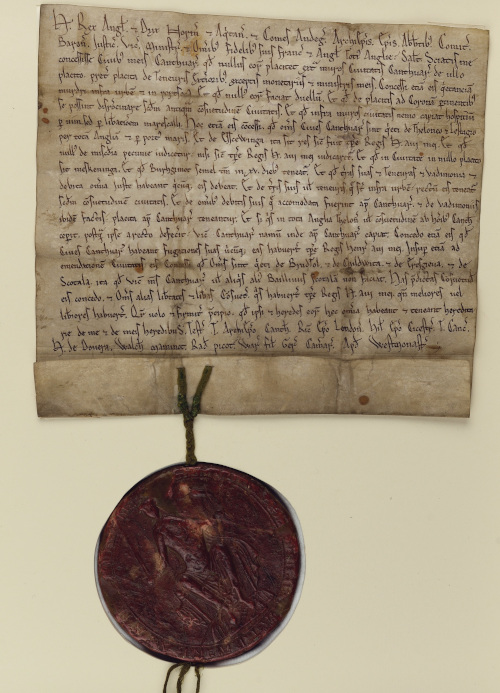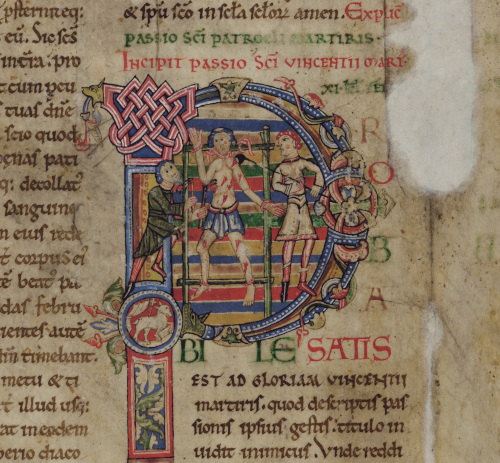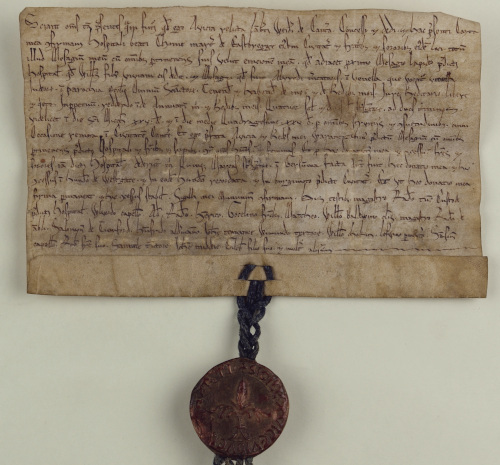Archives Hub feature for July 2019
On Saturday 6th July 2019 Canterbury hosted the fourth annual Medieval Pageant and Family Trail, commemorating the pilgrimage of King Henry II (r. 1154–1189) to the city in 1174. To mark the occasion, we are highlighting the medieval records relating to the Canterbury Cathedral Priory and the city held in our collections today.

Anglo-Saxon Canterbury
The Cathedral records date back to the ninth century and tell the story of the Church and community in Canterbury. Some 20 Anglo-Saxon charters are the oldest possessions of the Cathedral, predating the Norman Conquest of 1066 and any of the buildings standing today. These charters concern properties in Kent and across south-eastern England, containing unique evidence of the medieval history, topography and language of the area. A fine example from the collection is the so-called Godwine Charter, composed in c. 1020 (CCA-DCc/ChAnt/S/458).
Written in Old English, the charter details the sale of a swine pasture at Southernden (Swithraedingdaenne) by a certain Godwine to Leofwine the Red and is witnessed by Lyfing, Archbishop of Canterbury and others. This charter was the upper-half of a ‘chirograph’, a legal document written out twice on a parchment sheet with the word +CYROGRAPHUM+ between the text copies and cut through. This meant that both parties could have a copy, and the authority of the agreement could be proven at any time by matching the two record halves.

Lives of the Saints
As well as charters, the medieval Cathedral Priory (Christ Church) produced and housed a rich collection of illuminated manuscripts. The pre-Reformation Cathedral held over 6,000 manuscript books in its collections, more than any other medieval institution in England. In the late eleventh and twelfth centuries, the Cathedral’s own scriptorium wrote and decorated works in the Romanesque style of art, including a multi-volume Passionale (Lives of Saints). Originally seven volumes, in the 1570s and 1580s following the Dissolution the Passionale was dismembered for use as binding waste and covers for church court proceedings.

The remains of the Passionale survive today across several collections, with 60 leaves remaining in Canterbury (CCA-DCc/LitMs/E/42). The surviving leaves are an outstanding example of Romanesque art, featuring elements such as narrative decoration. The narrative of the text is placed within the body of the initial of the opening word, at the beginning of texts. This can be seen at the beginning of the life of the Spanish martyr St Vincent (d. 304). The initial ‘P’ contains a depiction of St Vincent’s death, being flayed by his pagan persecutors. The animated figures and bright array of colours capture the viewer’s attention, as well as the intricate foliate interlacing and animal forms.
A Site of Pilgrimage
Canterbury became a major centre of pilgrimage in the later twelfth century after the martyrdom of Archbishop Thomas Becket. He was murdered in the Cathedral on 29 December 1170, by four knights from the court of Henry II. Becket was canonised three years later, and pilgrims flocked to his shrine to pray for miracles and cures for ailments. Visitors to the city stayed in inns and hospitals, charitable institutions that offered shelter, food, spiritual and physical care. One such institution was the Hospital of St Thomas the Martyr, Eastbridge, founded in the late twelfth century.

The Eastbridge Hospital received grants and donations from the Cathedral Priory and wealthy members of the city. One charter dated c. 1200 is a grant from a widow named Avicia to Eastbridge of property in Jewry Lane, All Saints’ parish. The grant includes Avicia’s seal. Such charters provide useful evidence for the role of medieval women in Canterbury, and the city’s strong Jewish community during this time. Open to the public today to visit, Eastbridge recently featured in the ‘Plantagenet Canterbury’ episode of Britain’s Most Historic Towns shown on Channel 4 and presented by Professor Alice Roberts of the University of Birmingham.
The Canterbury Magna Carta
The dispute between Church and Crown continued into the thirteenth century, culminating in the issuing of Magna Carta (a Latin term meaning Great Charter) in 1215. Sealed by King John at Runnymede, Magna Carta made the King subject to the law, protected the rights of freemen and established the freedom of the Church in England. There are four known surviving copies of the 1215 Magna Carta today, including one charter held in the British Library that has been identified as Canterbury Cathedral’s copy of the Great Charter (London, British Library, Cotton Charter XIII 31A). Professor David Carpenter of King’s College, London uncovered the connection between Canterbury and the charter as part of the Magna Carta project that concluded in 2015, the 800th anniversary of the charter’s issue.

Professor Carpenter studied the text of a transcription made in the 1290s of the 1215 Magna Carta held at the Cathedral (DCc/Register/E, ff. 46v-48v), revealing unique readings of the text only present in the British Library charter. This exciting rediscovery confirms the survival of the Canterbury copy of the Great Charter, and strengthens the links between the Cathedral and the story of Magna Carta. Furthermore, Stephen Langton, Archbishop of Canterbury, was chief negotiator between the King and barons during the meetings at Runnymede in 1215, and probably involved in drafting the text of the charter. In 2016, the pre-Reformation archive of the Cathedral was added to the UNESCO UK Memory of the World Register, thus gaining recognition as one of the most important collections of its type.
For more information on the Medieval Pageant and Family Trail on 6 July 2019, see the webpage for more information: https://www.canterburybid.co.uk/canterbury-medieval-pageant/
Discover more about collections on the Canterbury Cathedral webpage: https://www.canterbury-Cathedral.org/heritage/archives-library/
Alison Ray, Assistant Archivist
Canterbury Cathedral Archives and Library
Related:
Records of the Dean and Chapter of Canterbury Cathedral, c800 – [ongoing]
All Canterbury Cathedral Archives collections on the Archives Hub.
Previous features on Canterbury Cathedral Archives Collections:
Heavenly Harmony: Music in the Collections of Canterbury Cathedral Archives and Library
All images copyright of the Chapter of Canterbury and reproduced with the kind permission of the copyright holders.
